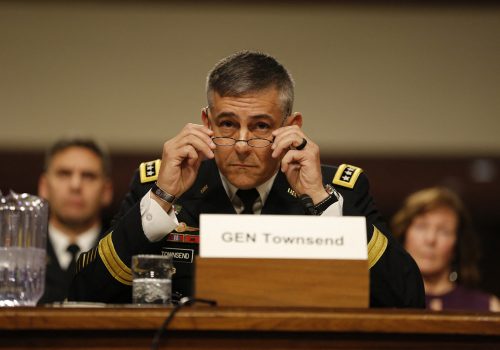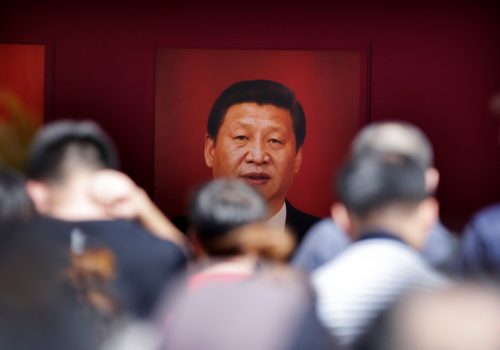How the US can regain the advantage in its next National Defense Strategy

This article was originally published by The National Interest and has been reprinted with their permission.
To seize the advantage, the next US National Defense Strategy (NDS) needs a paradigm adjustment, not a shift.
Retrospectively, the 2018 NDS is seen as an inflection point for US defense policy. It moved the dial from a two-decade-old focus on counterterrorism and security and stability operations to great power competition (GPC). This paradigm shift realigned Department of Defense (DoD) priorities to focus on the competition between the United States and China and Russia. The 2018 NDS set the stage for rightful attention on near-peer competitors, including preparation for high-end, kinetic warfare fought on the cutting edge of technology. But in the next NDS, President Joe Biden’s defense team must take a broader definition of competition if the United States is to succeed in deterring, defending, and shaping the strategic environment in its favor.
Two years on, the strategic perspective of the 2018 NDS seems prescient. The threats posed by the Chinese and Russians have manifested along the lines envisioned, as China continues aggressive pursuit of regional hegemony with an eye toward superpower status, and Russia has consistently demonstrated revanchist behavior.
While the previous NDS correctly identified that US foreign and defense policy would need to shift to counter these emergent threats, in practice it did not identify the full scope of great power competition. Similarly, it did not foresee the degree to which competition would impact the homeland or the expanding role that a pandemic response would play across the uniformed services. While acknowledging the need to compete in the “gray zone,” the previous NDS’s emphasis on the development of more lethal forces does not sufficiently emphasize the multi-spectrum nature of the current strategic environment. Moreover, the NDS did not examine as deeply the ongoing conflict in cyber, political, and economic domains and the extent to which DoD would become a key enabler for other government agencies both in competition and in crisis response. The next NDS must place a greater emphasis on fighting non-kinetic warfare but also on support of other agencies. For instance, as China and other challengers use coercion, information dominance, and cyber warfare, these key tools will penetrate and undermine US defenses without firing a shot. The Biden administration should develop a National Defense Strategy that capitalizes on the momentum generated by the 2018 NDS but also reorients efforts to account for the current hybrid war in which America is already engaged. A more nuanced understanding of the escalation ladder between low-end hybrid warfare and high-end, high-tech warfare—as they exist on a spectrum—will also help the DoD mitigate non-kinetic attacks from escalating to kinetic warfare.
This paradigm adjustment should be characterized by:
Firstly, a revised theory of competition that addresses the challenges of GPC from a whole of governments (federal, state, local, and allied) vantage point. The DoD has led intellectually and in practice through adopting a competitive posture vis-à-vis China and Russia, but too much of the space in which US national interests are under threat fall outside of the responsibility of the DoD. In the context of the NDS, this means identifying where the DoD will lead and where it will enable other departments’ efforts. This also implies work on a revised National Security Strategy (NSS) that both acknowledges all this, provides directive clarity on which efforts belong to DoD, and adopts a competitive posture for other departments.
The next NDS should acknowledge that conflict, rather than competition, is the appropriate term to describe the reality on the ground in certain domains. In areas of cyber, information, trade, diplomacy, and economics, US adversaries are engaged in non-kinetic warfare that exceeds the threshold of competitive behavior, making the United States a de facto belligerent. The next NDS should drive an intellectual shift within the DoD to a wartime mindset for continuous shaping operations. Like it or not, the United States is in a Phase 0 fight every day, and the DoD (and the rest of the government) should think and act accordingly.
Secondly, budgetary considerations are likely to loom larger than they did in 2018. Assuming a flat-at-best growth curve for the defense budget for the next four years, the Biden administration must provide clear priorities for where resources are to be expended. In a resource-constrained environment, hard choices must be guided by a recognition that, though China poses the most critical threat to US interests, the secondary Russian threat still requires deterrence. This “China as prime concern” framework should provide the lens for senior decision-makers to clearly delineate priorities and balance risk for the department. This will be particularly critical in terms of technology bets and alliance management considerations. The next NDS must be pointed about setting China as a priority and accordingly drive risk-based decisions that leverage allies to mitigate risks in other theaters.
Finally, the increasing overlap between internal and external threats to the homeland warrants serious consideration for the role that DoD resources will play in countering hybrid warfare. The collision of responsibilities for the Departments of Homeland Security, Justice, and Defense (to name the most obvious) in securing the homeland highlights the need for a review of associated authorities and limitations. Enabling US forces (and other agencies) to effectively counter these threats will require legal steps that pair resources with appropriate civilian authorities while also balancing individual civil and states’ rights considerations. In order to inform future congressional deliberation of these matters, this NDS should prompt the process of identifying what changes promote a more effective defense of the homeland and the associated risks to liberty these steps imply.
Seizing the advantage: The next US National Defense Strategy
Given the above, the four pillars of the next NDS could be as follows:
1. Posture the department for effective multi-spectrum competition: This first pillar should direct the DoD to reorient on GPC with emphasis on current hybrid warfare, recognizing that the United States is engaged in conflict and the department is necessary in shaping the fight. It should further direct the DoD to assist across the government in developing and integrating comprehensive, coherent policies that support its efforts to lead in the fight where designated and enable other agencies in specific areas. Ultimately, it must also address more explicitly the roles and bounds of the department in securing the homeland.
2. Modernizing and strengthening alliances: The 2018 NDS accurately identified the criticality of effective alliances and partnerships but, in practice, did not nurture them sufficiently. As the world adjusts to increasing multipolarity, US alliances must also. Building closer linkages in each spectrum with those allies that can best support US strategic goals should receive priority. Cooperation with allies will be all the more critical as the US faces a resource-constrained environment that requires difficult resource decisions related to posture, presence, and capabilities. Enhanced collaboration with allies that take on leadership roles in regional or theater contexts will help mitigate those risks, as allies act as “security exporters” in key domains and theaters where they are active, enabling the US to shift focus according to strategic priorities. The United States should find opportunities to shore up existing alliances with NATO and core Indo-Pacific allies (Japan, South Korea, Australia, etc.). Moreover, Washington should engage ASEAN and bolster the Quad, thereby turning existing partners—like India—into allies.
3. Lethality and force modernization: Formerly the 2018 NDS’s first pillar, efforts to ensure that the United States is capable of outfighting its enemies in a multi-spectrum conflict from the high to the low end remain important. This pillar must be pursued with the understanding that the United States must make key investments now to maintain a competitive edge against China in the long term. China’s advancements in some areas, including in hypersonic weapons and quantum computing, already pose risks to the US technological advantage. It is critical the United States make clear-eyed bets on novel defense innovations, including tradeoffs with legacy platforms, to prevent being overtaken technologically. If the United States makes investments today, its innovative aspects will prevail. Force design and weapons acquisition should be informed by closer cooperation with allies to make the most of their strengths as US forces go through recapitalization. Risks incurred by prioritizing the Indo-Pacific can be mitigated by dedication to improved interoperability in the European theater, as well as greater reliance on allies leading security in their own theaters with US support.
4. Departmental and acquisition reform: Efforts to modernize the department, particularly acquisition processes, remain vital to near- and long-term success. Ensuring the United States is secure will require more agile and innovative processes across the department. As China pursues a doctrine of Military-Civilian Fusion, enabling it to tap into emerging technologies more easily, the United States must prioritize acquisition reform to enable it to absorb technological advancements from the defense industry more rapidly and efficiently. The race for technological superiority will be critical to the future of US defense.
The incoming administration is faced with a strategic environment in which national security threats are multiplying and the United States is already in open conflict with Russia and China in non-kinetic domains. US security requires competitive posture for both high-end, high-tech warfare as well as low-end, hybrid warfare, as the DoD and other agencies pursue a whole of government approach to great power competition. Unlike during the Cold War, the United States and its allies will be unable to expend resources on a single primary threat. Resource constraints will force least-worst choices as often as best options. In order to effectively provide for the common defense in this environment, the DoD will need an NDS that equips the administration to use various means of national power to counter multiple threats, with different priorities over changing time horizons. This next NDS must address how the military fits into a broader strategic effort and enable the United States to serve as the leading power in a world of multipolarity.
Clementine G. Starling is deputy director of the Atlantic Council Scowcroft Center for Strategy and Security’s Forward Defense Initiative. Follow her on Twitter @StarlingCG.
Lieutenant Colonel Matthew R. Crouch, United States Marine Corps is the Academic Year 2020-2021 Commandant of the Marine Corps Senior Fellow to the Atlantic Council’s Scowcroft Center for Strategy and Security. He has operational experience throughout Asia, most recently in the Republic of Korea. A graduate of the United States Naval Academy, he holds master’s degrees in Political Science and International Business Administration and is an Olmsted Scholar.
The views and opinions expressed here are those of the author and do not necessarily reflect the official policy or position of any agency of the US government or other organization.
Forward Defense’s “Seizing the Advantage: The Next US National Defense Strategy” explores the future of defense policy through frank review of current policy, cogent expert analysis of the present security environment, and actionable recommendations for a strategy to meet future defense challenges. As part of that project, this essay is the first in a series that will offer thought-provoking commentary on how the Biden administration might effect changes in its opening days to seize the competitive advantage for the United States in ongoing great power competition.
Further reading
Image: Reuters





